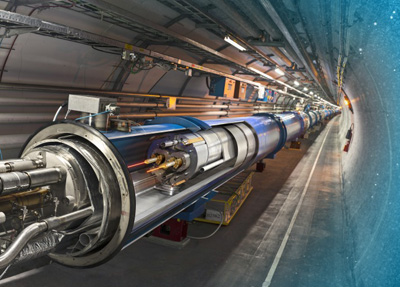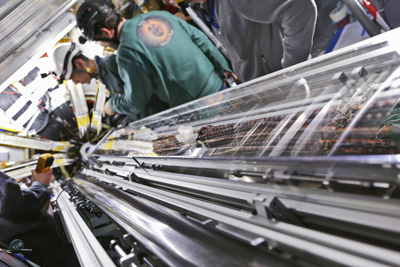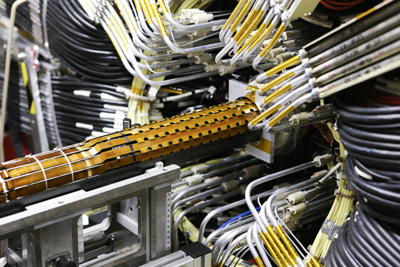The world's most powerful particle accelerator, the Large Hadron Collider, is even more powerful now as it begins its second run this month. The LHC's first run produced the breakthrough discovery of the Higgs boson in 2012. After shutting down for planned maintenance in early 2013, the LHC is now ready to explore new realms of particle physics over the next three years.
"The most exciting thing is that we'll be probing a new energy scale in the upcoming run. It's an opportunity to see what nature is like at these higher energies," said Howard Haber, professor of physics at UC Santa Cruz.
In addition to studying the Higgs boson with much greater precision, physicists will be looking for evidence of new physics beyond the "standard model," which describes all the known subatomic particles. Some theories, such as supersymmetry, predict the existence of exotic particles that should appear in high-energy collisions at the LHC. Another possibility is the discovery of extra dimensions beyond the familiar four dimensions of space time. Physicists could also identify the mysterious dark matter that makes up most of the mass in the universe. Dark matter candidates arise frequently in theories of physics beyond the standard model, including supersymmetry and extra dimensions.
"Dark matter stands out to me as the most interesting missing element at this time, and this next step in energy may provide what's needed to find it," said professor of physics Abe Seiden. "And, of course, we just might find something nobody's thought about."
World leader
UC Santa Cruz physicists have been at the forefront of U.S. participation in the LHC from the start. The Santa Cruz Institute for Particle Physics (SCIPP) is recognized as a world leader in the development of custom electronics and silicon sensors for state-of-the-art particle detection systems, and SCIPP physicists have been working on ATLAS, the largest of two general purpose detectors at the LHC, since 1994. Seiden led a team from 11 U.S. institutions that developed a new detector component for ATLAS called the Insertable b Layer (IBL). Installed in spring 2014, the IBL will be instrumental in tagging and identifying particles during the second run of the LHC.
ATLAS has multiple layers of devices to track and measure the jets of subatomic particles generated by high-energy collisions of proton beams within the LHC. The IBL is now the innermost layer, placing sensors closer to the collisions than ever before. "It's going to be the first thing the particles hit, so it provides critical measurements for determining where the particles are coming from," Seiden said.
"The IBL allows us to look at the particles coming out with higher precision, giving us greater sensitivity to find evidence of new physics," added UCSC physicist Jason Nielsen.
Seiden is currently managing U.S. research and development efforts for a large-scale ATLAS upgrade planned for future runs in the 2020s. Meanwhile, SCIPP physicists at CERN--the European particle physics lab in Geneva, Switzerland, where the LHC is located--have been working around the clock to get ATLAS ready for Run 2. "They're the ones who get called in the middle of the night. ATLAS was torn apart for two years for the upgrade, so they've been working on the integration and commissioning of the new components," Nielsen said.
Higher energy
The most dramatic change at the LHC is that the energy of the collisions will be almost doubled, reaching 13 TeV (tera electron volts) in 2015 compared to 8 TeV in 2012. The "luminosity" or intensity of the beams will also be higher, producing more collisions per second. The combination of increased energy and luminosity will mean a huge increase in the amount of data produced, giving more statistical power to the analyses. In addition, the higher-energy collisions could produce new particles and phenomena that have never been seen before.
The potential for discovering extra dimensions is particularly exciting to UC Santa Cruz physicist Stefano Profumo, whose theoretical papers have helped set the stage for the search for extra dimensions and dark matter at the LHC. A dark matter candidate emerges naturally from a relatively simple model of extra dimensions. Profumo and his colleagues analyzed this model, taking into account the mass of the newly discovered Higgs boson and cosmological measurements of the abundance of dark matter in the universe. Their calculations yield predictions for the mass of the dark matter particle and how it could be detected at the LHC.
"The LHC won't directly see dark matter. The evidence would be a lot of missing energy and two jets of particles, with characteristic features," Profumo said. If this model of extra dimensions is correct, dark matter particles would not have been seen during the first run, but should be detected at the higher energies of Run 2, he noted.
"If nature looks like this, we are bound to see something by the end of Run 2. That's what keeps me on the edge of my chair," Profumo said.
Supersymmetry, extra dimensions, and a variety of other ideas have been developed to address fundamental questions that the standard model left unanswered. "We're desperately searching for some new phenomenon that is going to indicate an enhancement to the standard model," Haber said. "I've worked on supersymmetry, so it would be great if that turns out to be right. But give me anything, any evidence of physics beyond the standard model, and then we'll figure out what it is."
Higgs boson
According to Haber, another important task for the LHC's second run is to learn more about the Higgs boson, which he said is unlike any other elementary particle. "The first run gave us a crude picture of what it is and its properties, but we would like to characterize it much more accurately," Haber said, noting that the souped up LHC will be able to produce ten times as many Higgs bosons as it did during the first run.
"We just scratched the surface in the first run, and most of the LHC horizon is open in front of us," he said. "There are some cynics who say the Higgs boson is the end of the story—there's been no hint of any new physics, so they're already getting frustrated. My answer is, give me a break—the LHC has so far only run at half the design energy and one-tenth the design luminosity at best. We're just getting started here."
As the LHC ramps up for its second run, the first proton beam is scheduled to circulate through the collider's 27-kilometer ring of superconducting magnets on March 23. The first collisions are expected to take place in late May or early June.
The international LHC collaboration involves about 10,000 scientists from 113 countries, including 1,700 scientists, students, and technicians from 96 U.S. institutions. At UC Santa Cruz, the project involves about ten faculty and senior scientists, a dozen postdoctoral researchers and graduate students, and about ten undergraduates working on various aspects of SCIPP's contributions.





